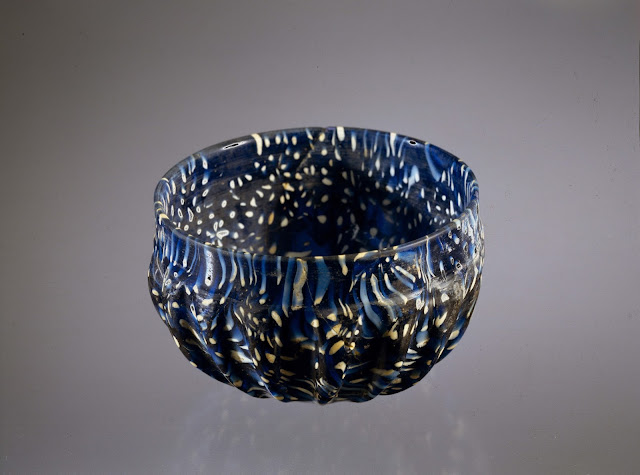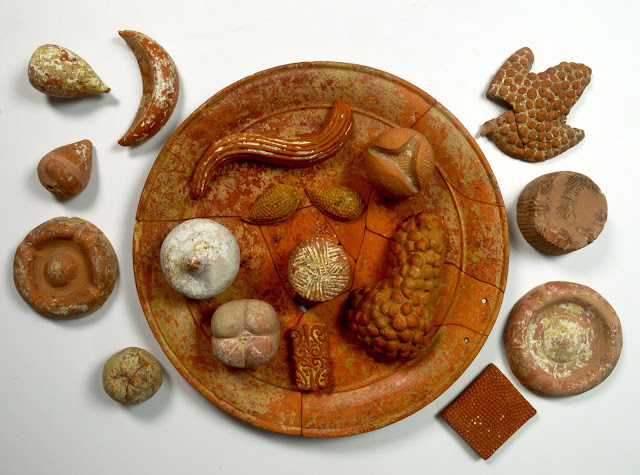When the ash from Mount Vesuvius began raining down on Pompeii in AD 79, people in and around the town were engaged in typical Italian activities – eating, drinking and producing food. Located in the sunny paradise of southern Italy, Pompeii was sandwiched between lush vineyards and fertile orchards to one side and the bountiful waters of the Bay of Naples on the other.
 |
Pompeii, exactly as it was in AD 79, has vanished. In the years after the disaster, survivors returned to recover what they could and looters made off with more. Excavations in the 18th century brought much to light but were conducted without the benefit of modern techniques, and heavy-handed reconstructions were of variable benefit. On top of this, a hail of different sorts assaulted the city again in the allied bombings of 1943. Yet Pompeii remains an archaeological miracle – one of the most visited historic sites on the globe and our most important portal to the ancient Roman world.
 |
| Fresco wall panel showing the distribution of bread, AD 40–79. Pompeii, House of the Baker [Credit: Museo Archeologico Nazionale di Napoli] |
 |
| Still life wall panel fresco showing a cockerel pecking at figs, pears and pomegranates, AD 45–79. Pompeii, House of the Chaste Lovers [Credit: Parco Archeologico di Pompeii] |
The exhibition shows the extent to which the Romans actually inherited their ‘Roman’ culinary ideas from other cultures. Just as the empire absorbed land across the Mediterranean, so were the Romans voracious and enthusiastic consumers of customs and traditions, successfully incorporating the practices and foodstuffs of conquered peoples.
 |
| Marble statue of Bacchus with a panther, AD 50–150. From the ruins of a temple in Piacenza, Emilia-Romagna [Credit: Museo Archeologico Nazionale di Napoli] |
 |
| Bronze fountain spout in the form of a seated fisherman holding a fishing rod, 50 BC–AD 50. Pompeii, House of the Small Fountain [Credit: Museo Archeologico Nazionale di Napoli] |
 |
| Rhyton (drinking or pouring vessel) in the form of a cockerel, AD 1–79. Pompeii, House of the Venus in a bikini [Credit: Parco Archeologico di Pompeii] |
From further south, at the Greek city of Paestum, come painted tomb panels, decorated with images of food and drink; and even offerings of artificial terracotta food including pomegranates, grapes, figs, almonds, cheeses, and focaccia bread. In Pompeii, preserved by the eruption, we find the remains of food offered to the Lares (household gods) – nuts, fruit, eggs and animal bones. Private offerings to the gods and feasting with the dead were practices which had become woven into daily life.
 |
| Still life wall panel fresco showing a rabbit nibbling at figs, AD 40–79. Pompeii [Credit: Museo Archeologico Nazionale di Napoli] |
 |
| Bronze reclining satyr from the rim of a vessel, 500–400 BC. Possibly from Chiusi, Tuscany [Credit: Ashmolean Museum, University of Oxford] |
Furthermore, as much as twenty percent of Pompeii itself was under cultivation in kitchen gardens and small vineyards, many of which served the city’s numerous bars and restaurants - tabernae, cauponae and popinae in descending order of respectability. The Ashmolean’s Conservation Department has analysed a group of pots and pans from one of these taverns, revealing the day-to-day workings of a ‘pub’. Establishments such as these served citizens of Pompeii at all levels, but perhaps especially those whose modest homes afforded little space for food preparation.
 |
| Monochrome mosaic panel of a skeleton holding two wine jugs, AD 1–50. Pompeii, House of the Vestal [Credit: Museo Archeologico Nazionale di Napoli] |
From these salubrious surroundings, the exhibition proceeds to the less-than savoury kitchens. Nothing here was ever touched (nor hardly ever seen) by the master and his family. Instead, slaves would tend the hearth and prepare food using an array of vessels and utensils which are familiar to modern cooks. Steam-cookers; colanders; animal shaped moulds; baking trays; pestle-andmortars; and portable ovens for al-fresco cooking have all been excavated from the kitchens of Pompeii.
 |
| Gilded silver cups decorated with repousse olive, vine and myrtle sprays (left to right), 50 BC–AD 150 [Credit: Ashmolean Museum, University of Oxford] |
 |
| Bronze strainer, 500–300 BC. Findspot unknown [Credit: Ashmolean Museum, University of Oxford] |
Tasty ingredients such as these began making their way to Britannia after the invasion by the emperor Claudius in AD 43. Burnt deposits from the Boudiccan uprising (AD 60–1) show the surprising extent of culinary imports from the continent and far reaches of the empire including olives, dates from the near-east and pepper from India. A whole range of new plants and even animals were brought to Britannia – everything from cherries, cabbages, carrots to rabbits. Fish and the famous fish sauce or garum, were both imported from the south of France and even North Africa.
 |
| Blue glass cup with white speckles, 50 BC–AD 50. Pompeii [Credit: Parco Archeologico di Pompeii] |
 |
| Marble head of Serapis wearing a modius (grain measure), AD 180–200. Walbrook Mithraeum, London [Credit: Museum of London] |
 |
| Gold, silver and bronze ithyphallic tray bearer in the guise of a placentarius (pastry seller), 100 BC–AD 79. Pompeii, House of the Ephebe [Credit: Museo Archeologico Nazionale di Napoli] |
Under the empire, food in Britain came to play an important role in religion and in death. Some important finds have been made in Chester where tombstones show the deceased as reclining banqueters. One particularly fine example is the gravestone of a woman called Dinysia (named for Dionysus) who is shown relaxing on a couch, wine cup in hand as if toasting her mourners.
The exhibition closes by reminding us that the diners of Pompeii were on borrowed time. The final story is that of the now-famous ‘resin lady’ of Oplontis. She was almost certainly a member of the family that owned the great emporium. She would have dined in the fine apartments above the warehouse and would have hoped, having lived a long life, to spend the afterlife with loved ones surrounded by the accoutrements of a banquet.
Instead, she was found amongst 60 people who had taken refuge in one of the storerooms. To judge by their possessions, they included both the owners and the slaves and farm workers they employed. The ‘resin lady’ had with her gold and silver jewellery, a string of cheap beads (perhaps a memento) and a door key. She hoped to return home, but never did.
Dr Xa Sturgis, Director of the Ashmolean, says: ‘It is a tremendous privilege to be able to show these extraordinary treasures, many for the first time in the UK. The generosity of the lenders, particularly the Parco Archeologico di Pompei, the Museo Archeologico Nazionale di Napoli, Parco Archeologico di Paestum who have lent remarkable and precious objects, has made this exhibition possible.
Last Supper in Pompeii promises a delicious glimpse into the world of Pompeii and Roman Britain, from the filthy kitchens, the shops and bars, to the triclinium banquets. In the food-obsessed culture of today, there is scarcely a better topic that can help us make a connection with the people of the ancient world.’
Last Supper in Pompeii is open until 12 Jan 2020.
Source: Ashmolean Museum [July 30, 2019]












No comments: